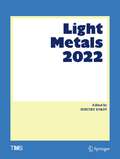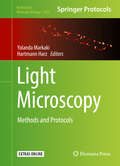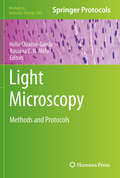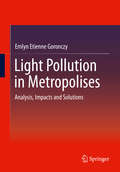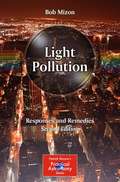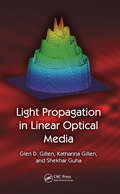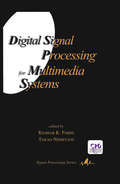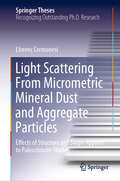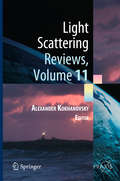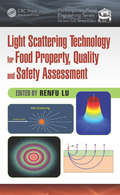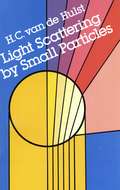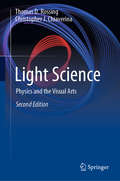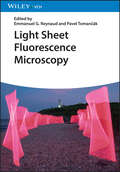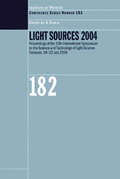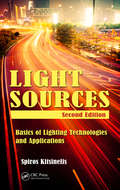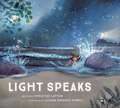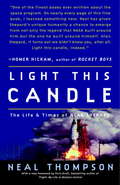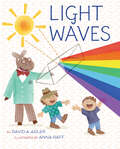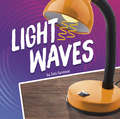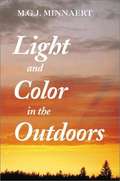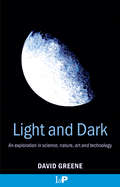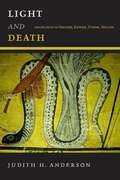- Table View
- List View
Light Metals 2022 (The Minerals, Metals & Materials Series)
by Dmitry EskinThe Light Metals symposia at the TMS Annual Meeting & Exhibition present the most recent developments, discoveries, and practices in primary aluminum science and technology. The annual Light Metals volume has become the definitive reference in the field of aluminum production and related light metal technologies. The 2022 collection includes contributions from the following symposia: • Alumina and Bauxite • Aluminum Alloys, Processing and Characterization • Aluminum Reduction Technology • Aluminum Reduction Technology Joint Session with REWAS: Decarbonizing the Metals Industry • Cast Shop Technology • Electrode Technology for Aluminum Production • Primary Aluminum Industry—Energy and Emission Reductions: An LMD Symposium in Honor of Halvor Kvande • Recycling and Sustainability in Cast Shop Technology: Joint Session with REWAS 2022
Light Metals 2023 (The Minerals, Metals & Materials Series)
by Stephan BroekThe Light Metals symposia at the TMS Annual Meeting & Exhibition present the most recent developments, discoveries, and practices in primary aluminum science and technology. The annual Light Metals volume has become the definitive reference in the field of aluminum production and related light metal technologies. The 2023 collection includes contributions from the following symposia: · 60 Years of Taking Aluminum Smelting Research and Development from New Zealand to the World: An LMD Symposium in Honor of Barry J. Welch · Alumina & Bauxite · Aluminium Industry Emissions Measurement, Reporting & Reduction · Aluminium Waste Management & Utilisation · Aluminum Alloys, Characterization and Processing · Aluminum Reduction Technology · Cast Shop Technology · Electrode Technology for Aluminum Production · Scandium Extraction and Use in Aluminum Alloys
Light Microscopy
by Yolanda Markaki Hartmann HarzThis volume addresses up-to-date light microscopy approaches and toolsets offered for live- or fixed-cell observations. The imaging strategies discussed in this book include confocal laser scanning and spinning disk confocal microscopy, FRET, FRAP, and laser microsurgery experiments. Chapters also describe the use of these imaging methodologies to study properties of a multitude of biomolecular targets in a broad range of model systems ranging from bacteria over tissue to whole animal imaging. Light Microscopy: Methods and Protocols puts special focus on system instrumentation parameters and sophisticated labeling and detection methods. Written in the highly successful Methods in Molecular Biology series format, chapters include introductions to their respective topics, lists of the necessary materials and reagents, step-by-step, readily reproducible laboratory protocols, and tips on troubleshooting and avoiding known pitfalls. Cutting-edge and thorough, Light Microscopy: Methods and Protocols offers the novice user with straightforward strategies to address biological questions, while providing the experienced researcher with the latest applications that can be useful in routine practices. This book also serves as a useful teaching manual in practical courses on light microscopy.
Light Microscopy
by Rossana C. Melo Hélio Chiarini-GarciaOf all scientific instruments, probably none has had more applications in the life sciences than the light microscope. In Light Microscopy: Methods and Protocols, expert researchers explore the basics and the latest advances in microscope instrumentation, sample preparation, and imaging techniques, all of which have been producing fundamental insights into the functions of cells and tissues. Chapters cover a variety of bright field and fluorescence microscopy-based approaches that are central to the study of a range of biological questions, providing information on how to prepare cells and tissues for microscopic investigations, covering detailed staining procedures, and exploring methods to analyze images and interpret the results accurately. Composed in the highly successful Methods in Molecular BiologyTM series format, each chapter contains a brief introduction, step-by-step methods, a list of necessary materials, and a Notes section which shares tips on troubleshooting and avoiding known pitfalls. Comprehensive and current, Light Microscopy: Methods and Protocols is an essential handbook for all researchers who are exploring the intriguing microscopic world of the cell.
Light Pollution in Metropolises: Analysis, Impacts and Solutions
by Emlyn Etienne GoronczyLight pollution (light smog, light pollution or light emissions) is a fundamental problem in metropolises with effects on flora, fauna and people. Accordingly, the first section of the book discusses the basics of light pollution and its effects on various organisms. The characteristics of light smog in the cities of Hanover, Warsaw, Boston, New York City and Toronto are then analysed and compared. But how can the problem be tackled? Existing measures for the prevention of light pollution are discussed and further novel approaches are shown by comparing the metropolises. The book is aimed primarily at practitioners in this field and helps to identify sources of emissions and identify suitable reduction measures. This book is a translation of the original German edition „Lichtverschmutzung in Metropolen“ by Emlyn Etienne Goronczy, published by Springer Fachmedien Wiesbaden GmbH in 2018. The translation was done with the help of artificial intelligence (machine translation by the service DeepL.com). A subsequent human revision was done primarily in terms of content, so that the book will read stylistically differently from a conventional translation. Springer Nature works continuously to further the development of tools for the production of books and on the related technologies to support the authors.
Light Pollution: Responses and Remedies (The Patrick Moore Practical Astronomy Series)
by Bob MizonThere have been many developments in the field of light pollution over the last few years, and this second edition of 'Light Pollution - Responses and Remedies' will introduce them in detail. Examples include the appearance of anti-light pollution legislation in various countries, new departures in lighting design, human health implications, and the growing realization among the general public that lighting is not always a good thing. In this title, author Bob Mizon discusses the various ways in which wasted artificial light has damaged the quality of modern life, and suggest solutions. This book is for anyone who has experienced glare, discomfort, or nuisance from poorly directed lights; has wondered why we waste so much money lighting the sky; or anyone who simply wants to see the stars instead of a baleful urban glow. "Light Pollution, 2nd Edition" offers practical and inexpensive solutions to the world-wide problem of wasted artificial light, and emphasizes that light pollution is not just an astronomers' problem, but affects everyone in various ways.
Light Propagation in Linear Optical Media
by Shekhar Guha Glen D. Gillen Katharina GillenLight Propagation in Linear Optical Media describes light propagation in linear media by expanding on diffraction theories beyond what is available in classic optics books. In one volume, this book combines the treatment of light propagation through various media, interfaces, and apertures using scalar and vector diffraction theories. After covering the fundamentals of light and physical optics, the authors discuss light traveling within an anisotropic crystal and present mathematical models for light propagation across planar boundaries between different media. They describe the propagation of Gaussian beams and discuss various diffraction models for the propagation of light. They also explore methods for spatially confining (trapping) cold atoms within localized light-intensity patterns. This book can be used as a technical reference by professional scientists and engineers interested in light propagation and as a supplemental text for upper-level undergraduate or graduate courses in optics.
Light Propagation in Periodic Media: Differential Theory and Design (Optical Science and Engineering #Vol. 81)
by Michel Neviere Evgeny PopovBased on more than 30 years of research on differential theories of gratings, this book describes developments in differential theory for applications in spectroscopy, acoustics, X-ray instrumentation, optical communication, information processing, photolithography, high-power lasers, high-precision engineering, and astronomy. Introducing the Fast Fourier Factorization approach to improve the convergence of a truncated series, the book examines multilayers, stacked gratings, crossed gratings, photonic crystals, and isotropic and anisotropic materials; techniques and examples in grating design; and Maxwell equations in a truncated Fourier space.
Light Scattering From Micrometric Mineral Dust and Aggregate Particles: Effects of Structure and Shape Applied to Paleoclimate Studies (Springer Theses)
by Llorenç CremonesiLight scattering from particles in the nanometric and micrometric size range is relevant in several research fields, such as aerosol science and nanotechnology. In many applications, the description of the optical properties of non-spherical, inhomogeneous particles is still inadequate or requires demanding numerical calculations. Lorenz–Mie scattering and effective medium approximations represent currently the main theoretical tools to model such particles, but their effectiveness has been recently called into question.This work examines how the morphology of a particle affects its scattering parameters from an experimental standpoint, supporting findings with extensive simulations. The dust content of Antarctic, Greenlandic, and Alpine ice cores is analysed with a particle-by-particle approach. Moreover, a study on colloidal aggregates shows that correlations among the fields radiated by primary particles are responsible for the poor agreement of effective medium approximations with experimental results. On the theoretical side, an interpretation in terms of the structure factor is given, which satisfactorily describes the data. The insights of this thesis are relevant for quantifying the contribution of mineral dust to the radiative energy balance of the Earth.
Light Scattering Reviews, Volume 11
by Alexander KokhanovskyThis is the eleventh volume in the series Light Scattering Reviews, devoted to current knowledge of light scattering problems and both experimental and theoretical research techniques related to their solution. The focus of this volume is to describe modern advances in radiative transfer and light scattering optics. This book brings together the most recent studies on light radiative transfer in the terrestrial atmosphere, while also reviewing environmental polarimetry. The book is divided into nine chapters: * the first four chapters review recent advances in modern radiative transfer theory and provide detailed descriptions of radiative transfer codes (e. g. , DISORT and CRTM). Approximate solutions of integro-differential radiative transfer equations for turbid media with different shapes (spheres, cylinders, planeparallel layers) are detailed; * chapters 5 to 8 focus on studies of light scattering by single particles and radially inhomogeneous media; * the final chapter discusses the environmental polarimetry of man-made objects.
Light Scattering Technology for Food Property, Quality and Safety Assessment (Contemporary Food Engineering)
by Renfu LuLight Scattering Technology for Food Property, Quality and Safety Assessment discusses the development and application of various light scattering techniques for measuring the structural and rheological properties of food, evaluating composition and quality attributes, and detecting pathogens in food. The first four chapters cover basic concepts, principles, theories, and modeling of light transfer in food and biological materials. Chapters 5 and 6 describe parameter estimation methods and basic techniques for determining optical absorption and scattering properties of food products. Chapter 7 discusses the spatially-resolved measurement technique for determining the optical properties of food and biological materials, whereas Chapter 8 focuses on the time-resolved spectroscopic technique for measuring optical properties and quality or maturity of horticultural products. Chapter 9 examines practical light scattering techniques for nondestructive quality assessment of fruits and vegetables. Chapter 10 presents the theory of light transfer in meat muscle and the measurement of optical properties for determining the postmortem condition and textural properties of muscle foods and meat analogs. Chapter 11 covers the applications of spatially-resolved light scattering techniques for assessing quality and safety of animal products. Chapter 12 looks into light scattering for milk and dairy processing. Chapter 13 examines the applications of dynamic light scattering for measuring the microstructure and rheological properties of food. Chapter 14 shows the applications of a biospeckle technique for assessing the quality and condition of fruits and vegetables. Chapter 15 provides a detailed description of Raman scattering spectroscopic and imaging techniques in food quality and safety assessment. Chapter 16, the final chapter, focuses on applications of light scattering techniques for the detection of food-borne pathogens.
Light Scattering by Ice Crystals
by Ping Yang Liou Kuo-Nan Yoshihide TakanoThis research volume outlines the scientific foundations that are central to our current understanding of light scattering, absorption and polarization processes involving ice crystals. It also demonstrates how data from satellite remote sensing of cirrus clouds can be combined with radiation parameterizations in climate models to estimate the role of these clouds in temperature and precipitation responses to climate change. Providing a balanced treatment of the fundamentals and applications, this book synthesizes the authors' own work, as well as that of other leading researchers in this area. Numerous illustrations are included, including three-dimensional schematics, to provide a concise discussion of the subject and enable easy visualization of the key concepts. This book is intended for active researchers and advanced graduate students in atmospheric science, climatology, and remote sensing, as well as scholars in related fields such as ice microphysics, electromagnetic wave propagation, geometric optics, radiative transfer and cloud-climate interactions.
Light Scattering by Small Particles
by H. C. Hulst"A must for researchers using the techniques of light scattering." - S. C. Snowdon, Journal of the Franklin InstituteThe measurement of light scattering of independent, homogeneous particles has many useful applications in physical chemistry, meteorology and astronomy. There is, however, a sizeable gap between the abstract formulae related to electromagnetic-wave-scattering phenomena, and the computation of reliable figures and curves. Dr. van de Hulst's book enables researchers to bridge that gap. The product of twelve years of work, it is an exhaustive study of light-scattering properties of small, individual particles, and includes a survey of all the relevant literature.Beginning with a broad overview of basic scattering theory, Dr. van de Hulst covers the conservation of energy and momentum; wave propagation in vacuum and in a medium containing scatterers; and polarized light and symmetry relations. The heart of the book is devoted to the rigorous scattering theory for spheres of arbitrary size (Mie theory) and to various modes of approximation such as the Rayleigh-Gaas approximation, the perfect reflection approximation, the geometrical-optics approximation, and others. Methods of computation are given with respect to different kinds of particles, bodies and phenomena: particles small or very large compared to the wavelength, absorbing and nonabsorbing spheres, water drops, circular cylinders, edge phenomena and surface waves, and many others. In the last part, the author covers the use of scattering and extinction experiments as a practical tool, including applications in chemistry, meteorology and astronomy.This book's comprehensive, lucid coverage of the field makes it a valuable source for all those interested in light-scattering theory. It is absolutely essential for researchers needing to employ light-scattering measurements, and its republication will be welcomed especially by those who have found this necessary source difficult to obtain. Over 400 references. 46 tables. 59 graphs. Subject and name indexes. 44 illustrations.
Light Science: Physics and the Visual Arts (Undergraduate Texts In Contemporary Physics Ser.)
by Thomas D. Rossing Christopher J. ChiaverinaIntended for students in the visual arts and for others with an interest in art, but with no prior knowledge of physics, this book presents the science behind what and how we see. The approach emphasises phenomena rather than mathematical theories and the joy of discovery rather than the drudgery of derivations. The text includes numerous problems, and suggestions for simple experiments, and also considers such questions as why the sky is blue, how mirrors and prisms affect the colour of light, how compact disks work, and what visual illusions can tell us about the nature of perception. It goes on to discuss such topics as the optics of the eye and camera, the different sources of light, photography and holography, colour in printing and painting, as well as computer imaging and processing.
Light Sheet Fluorescence Microscopy
by Emmanuel G. Reynaud Pavel TomančákLight Sheet Fluorescence Microscopy An indispensable guide to a novel, revolutionary fluorescence microscopy technique! Light sheet fluorescence microscopy has revolutionized microscopy, since it allows scientists to perform experiments in an entirely different manner and to record data that had not been accessible before. With contributions from noted experts in the fields of physics, biology, and computer science, Light Sheet Fluorescence Microscopy is a unique guide that offers a practical approach to the subject, including information on the basics of light sheet fluorescence microscopy, instrumentation, applications, sample preparation, and data analysis. Comprehensive in scope, the book is filled with the cutting-edge methods as well as valuable insider tips. Grounded in real-world applications, the book includes chapters from major manufacturers that explores their recent systems and developments. In addition, the book hightlights a discussion of a “do-it-yourself” light sheet microscope, making the technique affordable for every laboratory. This important textbook: Serves as an easy-to-understand introduction to light sheet-based fluorescence Includes numerous tips and tricks for advanced practitioners Provides in-depth information on hardware and software solutions for a straightforward implementation of light sheet fluorescence microscopy in the lab Includes chapters from the major manufacturers including Zeiss, Leica, Lavision Biotech, Phase View, and Asi Aimed at cell biologists, biophysicists, developmental biologists, and neuro-biologists, Light Sheet Fluorescence Microscopy offers a comprehensive overview of the most recent applications of this microscopy technique.
Light Sources 2004 Proceedings of the 10th International Symposium on the Science and Technology of Light Sources (Institute of Physics Conference Series)
by A ZissisHeld every three years, The International Symposia on the Science and Technology of Light Sources (LS) provide a unique forum for the international community of engineers, scientists, research organizations, and academia from the lighting industry. In Light Sources 2004, leaders in their respective fields discuss the latest findings and exciting de
Light Sources: Basics of Lighting Technologies and Applications
by Spiros Kitsinelis Spyridon KitsinelisDecide Which Lighting Technology Is Best for Your ApplicationLight Sources, Second Edition: Basics of Lighting Technologies and Applications presents an overview of the three main technologies that have produced the numerous families of lighting products on the market today: electrical incandescence, electrical gas discharges, and semiconductor lig
Light Speaks
by Christine LaytonSpare, lovely text and gorgeous, color-saturated illustrations make a compelling presentation. An enchanting picture book about the joyful, mysterious, awe-inspiring messages of light, whether emanating from a firefly or the sun, fireworks or the Big Bang, boats at sea or a bolt of lightning, a movie projector or a rainbow. Luciana Navarro Powell’s illustrations follow a group of kids through a magical day and evening in a seacoast town, while Christine Layton’s lyrical text explores the natural history of light. Backmatter provides further adventures in the science of light.
Light Spectroscopy
by Dr David HarrisSpectrophotometry and spectrofluorometry are core techniques used throughout biology and medicine. These techniques evolve continuously and this book provides information on the latest advances in spectroscopic methods.
Light This Candle: The Life and Times of Alan Shepard
by Neal ThompsonAlan Shepard was the brashest, cockiest, and most flamboyant of America's original Mercury Seven, but he was also regarded as the best. Intense, colorful, and dramatic, he was among the most private of America's public figures and, until his death in 1998, he guarded the story of his life zealously. Light This Candle, based on Neal Thompson's exclusive access to private papers and interviews with Shepard's family and closest friends--including John Glenn, Wally Schirra, and Gordon Cooper--offers a riveting, action-packed account of Shepard's life.
Light Waves
by David A. AdlerFascinating physics facts a young scientist needs to know, from one of the most trusted teams in STEM for children!This kid-friendly introduction to the physics of light covers the basics of solar energy, the electromagnetic spectrum, photon particles, light scattering, and reflection and refraction. Readers will follow along as two children and a cow in a lab coat learn how light works in realistic and imaginative scenarios.With accessible language, grounded examples, and easy, hands-on experiments you can do with household items, David A. Adler explains the basics of how light travels and bends. Anna Raff's bright, humorous illustrations make an intimidating topic easy-- and fun!-- to understand. This colorful picture book is a perfect supplement to lessons on light waves, and a great way to explore the topic at home. Named a finalist for the AAAS/Subaru SB&F Prize for Excellence in Science Books in the Children's category, Light Waves is a must-have book for all self-professed science nerds!
Light Waves (Waves in Motion)
by Julia Garstecki-DerkovitzYou see your shadow outside on a sunny day. A rainbow appears in the sky after a storm. Light waves are all around us, even when it's dark. With engaging, at-level text and colorful images, readers will learn about light waves and how we use them every day.
Light and Color in the Outdoors
by L. Seymour M. G. J. MinnaertLight and Color in the Outdoors by the Dutch astronomer Marcel Minnaert (1893-1970) is a classic among books on the physics of nature. In its pages Minnaert will show you where to find the extraordinary array of light and color phenomena that may be seen in the open air; in every case he discusses their physical explanations and connections to other related phenomena. His book is intended for everybody who loves the outdoors: many of the treasures of nature presented here may even be observed in a crowded city.
Light and Dark: An exploration in science, nature, art and technology
by David GreeneAn entertaining, instructive, diverse, and unusual book, Light and Dark: An Exploration in Science, Nature, Art and Technology encompasses a wide range of topics not normally found in one book.With more than 100 diagrams, graphs, and figures, the subjects discussed include the history of artificial lighting, eclipse cycles, light-sensitive eyeg
Light and Death: Figuration in Spenser, Kepler, Donne, Milton
by Judith H. AndersonLight figures being; darkness, death. Bridging mathematical science, semantics, rhetoric, grammar, and major poems, Judith H. Anderson seeks to negotiate writings from multiple disciplines in the shared terms of poiesis and figuration rather than as cultural opposites. Analogy, a type of metaphor, has always been the connector of the known to the unknown, the sensible to the infinite. Anderson’s study moves from the figuration of light and death to the history of analogy and its pertinence to light in physics and metaphysics, from Kepler to Donne, Spenser, and Milton. Topics proliferate: creativity, optics, the relation of literature to science, the methodology of thought and argument, and the processes of narrative, discovery, and interpretation.
